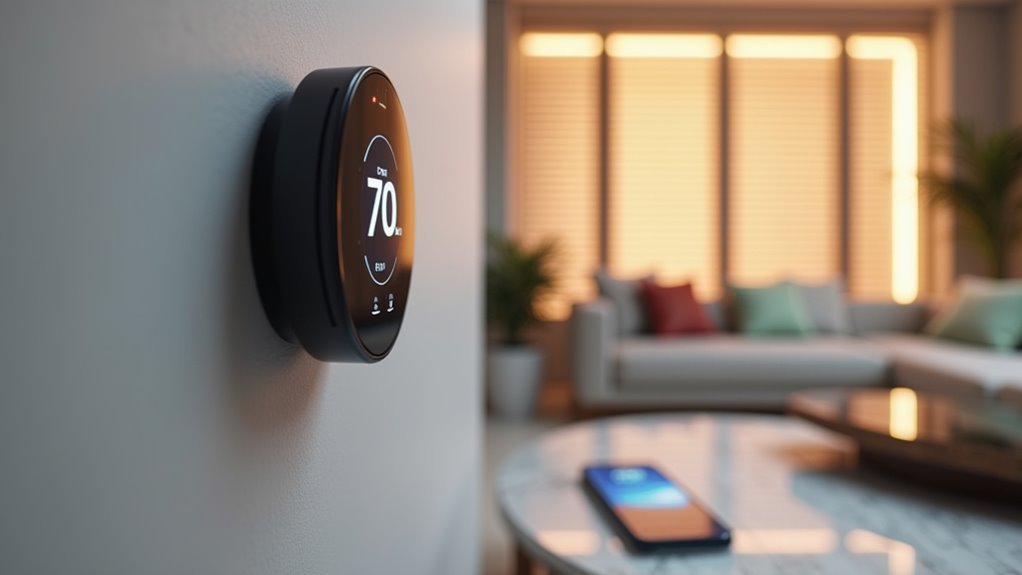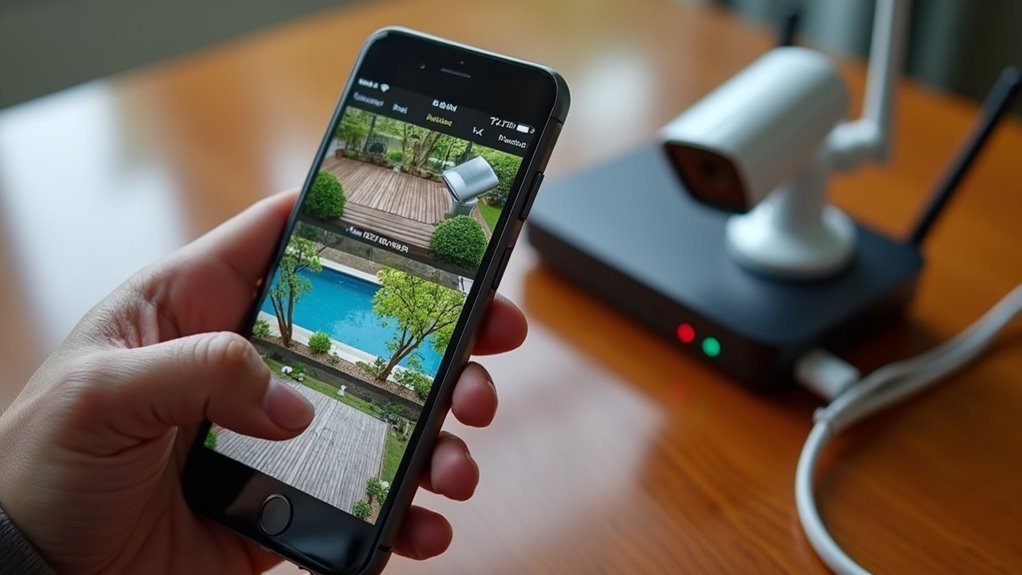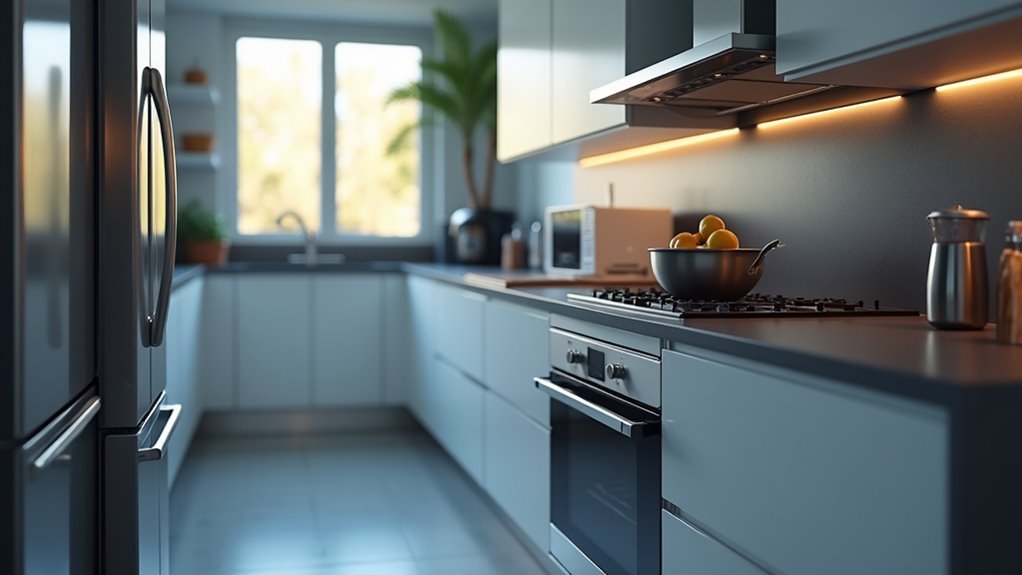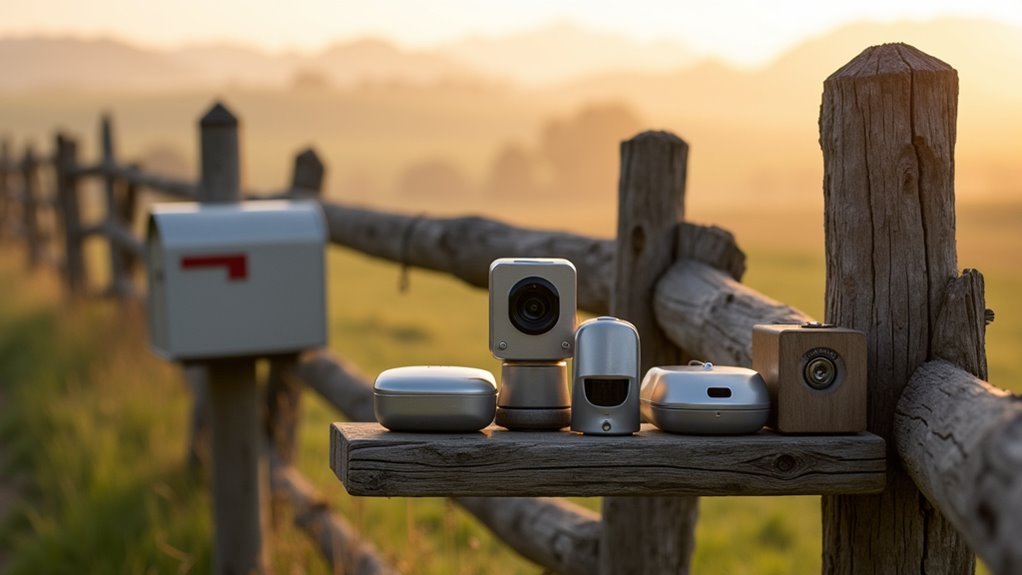You’ve probably heard countless promises about smart home convenience, but most systems leave you dependent on corporate servers and vulnerable to outages. Local control home systems flip that script entirely—they put you back in charge of your data, your devices, and your digital life. When your internet goes down or a cloud service shuts down, your home keeps running exactly as it should. But there’s much more to this independence than basic reliability.
Privacy and Data Sovereignty: Your Information Stays Home

While cloud-connected smart home devices transmit your personal data to remote servers, local control systems keep that information exactly where it belongs—in your home.
You’ll gain true data sovereignty, retaining complete ownership and control over your personal information without sharing it with external entities.
Your security footage, personal preferences, and usage patterns remain on-site through local data storage. This approach eliminates dependency on cloud services, protecting you from potential data breaches and service interruptions.
You’re no longer vulnerable to third-party data collection or surveillance.
Local processing enhances privacy compliance by minimizing data sharing requirements, aligning with regulations and your individual preferences.
You’ll maintain complete control over who accesses your information, ensuring your smart home truly serves your interests first.
Reliability During Internet Outages and Service Disruptions
When your internet connection fails, cloud-dependent smart home systems become expensive paperweights—but local control systems continue operating seamlessly. Your smart home devices maintain full functionality because they don’t rely on external servers or internet connectivity.
Local control guarantees your home automation keeps running when you need it most:
Local control ensures your smart home automation continues functioning reliably when internet outages would otherwise disable cloud-dependent systems.
- Security systems continue monitoring and alerting during outages
- Climate control maintains comfortable temperatures automatically
- Lighting schedules and motion sensors operate without interruption
- Door locks and access controls function normally
- Critical automation routines execute on schedule
Your system processes commands instantly through local networks using protocols like Z-Wave and Zigbee.
These wireless standards create robust device-to-device communication that’s unaffected by internet disruptions, guaranteeing your smart home devices remain responsive and reliable.
Instant Response Times Through Local Network Processing

Beyond maintaining functionality during outages, local control systems deliver lightning-fast response times that cloud-based alternatives can’t match. When you command your smart devices, local network processing executes actions instantly without routing data through external servers.
You’ll experience response times as low as milliseconds, while cloud services often suffer delays ranging from several seconds to minutes. This speed proves essential for critical applications like security alerts and automated lighting, where delays impact safety and convenience.
Your commands execute immediately since they don’t rely on internet bandwidth or connectivity stability. Local network processing eliminates external data transmission, ensuring instant response times for all automations.
You maintain consistent, immediate control over your smart home environment regardless of internet conditions.
Long-Term Independence From Cloud Service Dependencies
Although cloud services dominate today’s smart home market, local control systems free you from the uncertainty of external dependencies that can disappear without warning.
When you invest in systems like Home Assistant or Hubitat, you’re building home automation that operates independently of corporate decisions and service shutdowns.
Your local control setup provides lasting benefits:
- Hardware longevity – Your devices remain functional as long as the physical components work, avoiding planned obsolescence.
- Service continuity – No risk of manufacturers discontinuing cloud platforms or changing subscription models.
- Data ownership – All personal information stays within your home network permanently.
- Operational reliability – Internet outages won’t disable your home automation functions.
- Cost stability – No recurring cloud service fees or surprise pricing changes.
This independence guarantees your smart home investment maintains its value indefinitely.
Future-Proofing Your Smart Home Investment

Local control systems protect your current investment while positioning your smart home to adapt and grow with emerging technologies.
When you choose open-source platforms like Home Assistant, you’re building on foundations that evolve through community innovation rather than corporate roadmaps. Your smart home automation won’t become obsolete when manufacturers discontinue products or pivot strategies.
You’ll maintain full control over system updates and feature additions, ensuring compatibility with new devices as they emerge.
Local processing capabilities mean your infrastructure can handle advanced automation without requiring cloud upgrades or subscription services. This approach eliminates vendor lock-in, allowing you to integrate cutting-edge technologies seamlessly.
Your investment grows stronger over time, adapting to future innovations while maintaining the reliability and privacy that local control provides.
Home Assistant: The Open-Source Powerhouse for Local Control
When you’re ready to embrace true local control, Home Assistant stands as the most thorough open-source platform available. This powerhouse transforms your home into a privacy-focused automation hub that operates independently of cloud services.
Home Assistant’s extensive capabilities include:
Over 1000 device integrations, advanced automation, local data storage, cloud independence, and community support make Home Assistant unmatched.
- Integration with over 1000 brands and devices for maximum compatibility
- Advanced automation engine enabling custom, personalized home settings
- Local data storage keeping your information secure within your home
- Complete independence from third-party cloud services and data collection
- Active community support providing extensive resources and troubleshooting assistance
You’ll benefit from advanced automation features that learn your preferences while maintaining complete data privacy.
The platform’s versatility means you’re not locked into specific manufacturers or ecosystems. With local storage and processing, your smart home remains functional even during internet outages, giving you reliable control over your environment.
Hubitat Elevation: User-Friendly Local Automation
For users seeking powerful local automation without the complexity, Hubitat Elevation delivers an ideal balance of sophistication and simplicity. This smart home hub operates entirely locally, ensuring your devices respond instantly without internet dependency.
You’ll appreciate how it seamlessly integrates Z-Wave and Zigbee devices, creating a unified ecosystem regardless of manufacturer.
The platform’s intuitive interface makes creating complex automation rules surprisingly straightforward. You can establish triggers based on device states, time schedules, or environmental conditions without programming expertise.
Whether you’re dimming lights at sunset or coordinating security responses, the system handles intricate scenarios effortlessly.
What sets Hubitat apart is its vibrant community. You’ll find shared automation blueprints, troubleshooting support, and creative ideas that expand your smart home’s capabilities.
This local automation solution proves you don’t need cloud services for sophisticated home control.
Z-Wave and Zigbee: The Foundation of Offline Connectivity
While cloud-dependent smart home systems leave you vulnerable to internet outages and privacy concerns, Z-Wave and Zigbee protocols form the backbone of truly independent home automation.
Z-Wave operates on 908.42 MHz frequency, eliminating Wi-Fi interference while creating robust mesh networks. Zigbee uses 2.4 GHz frequency with similar mesh capabilities, allowing direct device communication that strengthens your entire system.
Both protocols offer distinct advantages:
- Mesh networking – Devices extend range by communicating through each other
- Low power consumption – Battery-powered sensors last years, not months
- Local processing – No internet required for device control and automation
- Enhanced security – Data stays within your home network
- Wide compatibility – Seamless integration with Home Assistant and Hubitat hubs
You’ll enjoy reliable automation that functions regardless of internet connectivity.
Security Systems That Function Without External Servers
You’ll want security systems that operate independently from cloud services and external servers to maintain complete control over your home’s protection.
Local camera storage through Network Video Recorders (NVRs) keeps your footage secure on your own network, while RTSP-enabled cameras provide direct video streaming without third-party dependencies.
Offline motion detection systems can trigger immediate responses like activating lights or alarms, ensuring your security remains functional even during internet outages.
Local Camera Storage
Modern security systems don’t need to phone home to keep your property safe. Local camera storage solutions provide thorough home control over your surveillance footage without relying on external servers. You’ll maintain full privacy while ensuring continuous operation, even during internet outages.
Network Video Recorders (NVRs) offer extensive management for your camera network:
- Store video streams directly on your premises without internet dependency
- Integrate seamlessly with Home Assistant using RTSP protocols
- Eliminate monthly subscription fees and data collection risks
- Maintain 24/7 surveillance functionality during connectivity issues
- Keep sensitive footage within your local network boundaries
You’re choosing cameras with built-in storage capabilities means you’ll never lose critical security footage to server downtime or connectivity problems.
This approach delivers cost-effective, secure monitoring that operates independently from cloud services.
Offline Motion Detection
When internet connections fail, offline motion detection systems continue protecting your home through local sensors and processing units that operate independently from external servers.
You’ll find Z-Wave and Zigbee motion detectors communicate directly with local control hubs like Home Assistant, delivering instant responses when movement’s detected within your property.
Your offline motion detection setup maintains complete functionality during internet outages, ensuring uninterrupted monitoring and protection.
These systems generate alerts and notifications without requiring external connectivity, keeping your security operations running smoothly regardless of network status.
Climate Control With Complete Local Operation
You can achieve complete climate independence by implementing Z-Wave and Zigbee thermostats that operate without cloud connectivity, ensuring your heating and cooling systems function reliably during internet outages.
Smart thermostatic radiator valves extend this control to individual rooms, letting you create customized temperature zones that respond to local sensors rather than external servers.
This approach gives you direct command over your home’s climate through local API access, eliminating the vulnerabilities and dependencies that come with cloud-based systems.
Smart Thermostat Independence
Since internet outages can leave cloud-dependent thermostats completely non-functional, local control smart thermostats offer a reliable alternative that keeps your climate control running regardless of connectivity issues.
These systems use protocols like Z-Wave or Zigbee to maintain independence from cloud services while delivering advanced functionality.
You’ll gain significant advantages with local control smart thermostats:
- Complete operational independence – Functions fully during internet outages without losing programmable features
- Direct API integration – Seamlessly connects with Home Assistant and other automation platforms for customized scheduling
- Real-time environmental monitoring – Pairs with local sensors for precise temperature and humidity adjustments
- Zone-based heating control – Integrates with smart TRVs for targeted room-by-room climate management
- Privacy and cost benefits – Eliminates subscription fees and data collection concerns
Zone Control Benefits
Zone control transforms energy efficiency by allowing you to heat and cool specific areas of your home based on actual occupancy and preferences.
You’ll save considerably on energy costs by targeting only the spaces you’re actually using rather than conditioning your entire home uniformly.
Smart thermostatic radiator valves provide granular room-by-room control, letting you customize temperatures for each zone according to your family’s needs.
Your energy management becomes more sophisticated when Z-Wave and Zigbee thermostats integrate with local automation systems, eliminating cloud dependencies while maintaining precise control.
Real-time temperature and humidity sensors feed data directly to your local system, optimizing heating and cooling schedules automatically.
This immediate response capability means your comfort preferences are met instantly without the delays typical of cloud-based solutions.
Local Video Storage and Network Camera Solutions
When you prioritize privacy and control over your home security data, local video storage solutions offer a compelling alternative to cloud-based surveillance systems.
Network Video Recorders (NVRs) keep your footage securely within your home network, eliminating dependence on external servers.
Network camera systems with RTSP support provide direct streaming to your local storage, ensuring real-time monitoring regardless of internet connectivity. You’ll maintain complete surveillance functionality even during outages.
Key advantages include:
- Motion detection and alerts integrated with home automation platforms like Home Assistant
- Immediate access to live streams and recorded footage for faster incident response
- No mandatory cloud accounts required for core functionality
- Enhanced privacy through data retention within your network
- Continuous operation independent of internet service availability
Energy Management and Monitoring On Your Terms
Taking control of your home’s energy consumption becomes straightforward with local monitoring systems that operate independently of cloud services. You’ll track real-time usage patterns, monitor solar panel production, and receive actionable insights without external dependencies.
| Feature | Benefit | Control Level |
|---|---|---|
| Real-time monitoring | Track consumption patterns instantly | Complete local access |
| Solar integration | Optimize energy usage with production data | Your data stays home |
| Automation rules | Reduce peak-hour consumption automatically | Set your own schedules |
| Device integration | Detailed energy overview | Connect what you choose |
Local control energy management empowers you to make informed decisions about usage while promoting sustainable practices. You’ll set automation rules for energy-intensive devices, reducing utility bills through smart scheduling. These systems integrate seamlessly with various monitoring devices, giving you complete oversight of home efficiency without relying on external services.
Device Compatibility and Integration Strategies
You’ll need to carefully select communication protocols and integration methods to build a robust local smart home system.
Your protocol choices—whether Z-Wave, Zigbee, or local Wi-Fi devices—directly impact your system’s reliability and offline functionality.
Smart hub integration strategies become essential when you’re connecting devices from different manufacturers while maintaining seamless local control.
Protocol Selection Strategies
Since smart home ecosystems rely heavily on communication protocols to function effectively, choosing the right protocol becomes the foundation of your entire local control system.
Your protocol selection strategies directly impact device compatibility, automation reliability, and independence from cloud services.
Consider these essential factors when implementing protocol selection strategies:
- Z-Wave and Zigbee compatibility – These protocols support thousands of devices while maintaining local control
- Local API access verification – Prioritize devices that explicitly offer local operation capabilities
- Unified protocol adoption – Using consistent protocols enables seamless automation and complex scenarios
- Home Assistant integration – Leverage support for over 1000 brands through proper protocol choices
- Community resource monitoring – Stay updated on new supported devices and emerging protocols
Your protocol decisions determine your system’s long-term functionality and expansion possibilities.
Hub Integration Methods
After establishing your protocol foundation, integrating devices into your local control hub requires strategic approaches that maximize compatibility while guaranteeing seamless operation.
You’ll find that hub integration methods vary considerably between platforms, with Home Assistant supporting over 1000 brands and devices compared to more limited alternatives.
Focus on selecting devices that explicitly state local operation compatibility to maintain offline functionality.
Z-Wave and Zigbee protocols offer the most reliable integration paths since they don’t depend on cloud services.
Your local control system benefits from customizable automation strategies that let you create tailored workflows matching your specific needs.
Leverage community-driven resources like Home Assistant forums for troubleshooting compatibility issues and discovering proven integration techniques that secure ideal device performance.
Building Your Infrastructure for Maximum Local Control
When designing a local control system that won’t fail you during power outages or internet disruptions, hardwired connections form the backbone of reliable home automation. Your home technology infrastructure requires careful planning to maximize performance and minimize single points of failure.
Building a robust control system starts with strategic wiring decisions:
Strategic wiring forms the foundation of any reliable home automation system that operates independently during outages.
- Run multiple Ethernet cables from each room to a central server closet for ideal network connectivity.
- Install hardwired contact sensors instead of wireless alternatives for critical security functions.
- Implement Power Over Ethernet (PoE) for cameras and compatible devices to simplify installation.
- Position your automation controller in the server closet to reduce communication latency.
- Review local regulations for low-voltage wiring compliance before starting DIY installations.
This foundation guarantees your system operates independently when external services fail.
Frequently Asked Questions
What Home Automation System Is the Best?
You’ll find Home Assistant offers the best flexibility with 1000+ integrations, while Hubitat provides easier setup. If you prefer professional installation, Control4 delivers polish. Choose based on your technical comfort level.
What Is an Example of a Control System That Might Be Used in Someone’s House?
You’d typically find a smart thermostat control system in your house. It automatically adjusts temperature based on your schedule, sensors detect occupancy, and you can remotely control heating and cooling through your smartphone app.
What Is the #1 Product That Users Wish to Control With Home Automation?
You’ll find smart lighting is the number one product users want to control with home automation. It’s popular because you can customize ambiance, improve energy efficiency, enhance security, and easily integrate with voice assistants.
What Is the Most Expensive Home Automation System?
You’ll find Crestron systems are the most expensive home automation option, easily exceeding $100,000 for thorough setups. Control4 also commands premium pricing, ranging from $15,000 to over $100,000 depending on complexity.





Leave a Reply